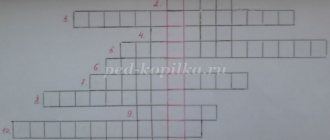A junior architect can easily and freely express his ideas on paper only if he knows how to draw without directly turning to nature. Completing some tasks and exercises to develop creative thinking and imagination is not enough. Only in synthesis with other educational disciplines of a special architectural and graphic direction, where the student becomes acquainted with orthogonal projection, design features of buildings, with the quests of architects in different historical eras, with the main functions of architecture, etc., will he be able to comprehend the music of frozen stone.
But the main thing in this process of shaping a future specialist is the accumulation of visual impressions. A supply of vivid artistic images arises only through drawing from life. It is necessary to achieve a creatively active vision of nature, to cultivate one’s worldview and attitude towards the surrounding reality and architecture.
Getting to know an architectural detail
The initial stage of this process is through the study of architectural detail. It is known that an architectural structure has the strongest emotional and aesthetic impact on a person only in synthesis with painting and sculpture, gardening and decorative arts. By drawing plaster casts of the decorative decoration of architectural buildings, the student masters the laws of perspective construction of complex shapes, studies the plastic fundamentals and proportions of their artistic expression, constructive logic, and also improves his graphic skills. Familiarity with an architectural detail is the starting basis for drawing the entire structure during summer plein air practice - the main stage of working on an architectural drawing.
Architecture, being a human habitat, has an informational impact on his feelings. By studying the logic of the patterns of an architectural organism, the student should see a holistic image of the architectural composition in the combination of various structures, shapes and details. The ability to see not only geometric shapes and proportions, but also the position of the building in space, the general masses of architectural forms, the texture of the material, color and light and shade, connection with the environment in combination with knowledge of the principles and methods of constructive and structural drawing, skills in working with various graphic materials create fertile ground for the formation of professional qualities of a future specialist.
You may be interested in: Drawing polyhedra and bodies of revolution
It is advisable to support long-term drawings of architectural and spatial forms with quick sketches and sketches. The laconicism of the sketch, the bold use of various materials and execution techniques develop the efficiency of the graphic language. When translating his creative ideas into subsequent professional activities, the student will constantly turn to quick drawing.
Architecture among other arts
Architecture among other arts
9th grade
Miass MCOU "Secondary School No. 13" Ermilina O.G. 2014
“Beauty lies in the way you move through space.”
American architect
F. Johnson
In relation to other arts, architecture forms the basis of the environment in which their works exist and determines the possibilities of their synthesis.
In 989–96, the first stone church of the Assumption of the Virgin Mary was built in Kyiv - the so-called. The Church of the Tithes (destroyed during the Mongol invasion; the remains of the foundation have been preserved) is a large 25-domed six-pillar church, surrounded on both sides by lowered galleries, which gave the entire temple a pyramidal appearance (pyramidal structure, mass accumulation - features not characteristic of Byzantine architecture). The church was richly “decorated” with frescoes, mosaics, and carvings.
Iconostasis
an altar partition, more or less continuous, from the northern to the southern walls of the temple, consisting of one or several rows of orderly placed icons, separating the altar part of the Orthodox church from the rest of the room.
“Classical” high iconostases of the 15th–17th centuries
- The iconostasis had 4 rows of icons. Above the local row, which has not survived, there was a huge Deesis rank (height 314 cm). 13 icons from it have survived. There are unproven suggestions that there were more. Above there was a festive row, of which only 5 icons survived. The iconostasis ended with waist-length icons of the prophets (this is the first example of the prophetic order); only 2 of them have survived. It is interesting that studies of the fastening of the iconostasis revealed the uneven arrangement of the rows of icons. The Deesis rite was brought forward to the worshipers, and the holidays were located a little deeper towards the altar. An important feature of the iconostasis was its division into five parts - it stood in parts in three openings of the altar apses and at the ends of the outer naves. This is confirmed by frescoes preserved on the western faces of the eastern pillars. Among them are figures from the 12th century and medallions with martyrs, executed in 1408. They could not be covered by the iconostasis created at the same time.
- “The Savior is in power” from the iconostasis of the Assumption Cathedral in Vladimir. Workshop of Andrei Rublev and Daniil Cherny.
Fresco
Painting on wet plaster, one of the wall painting techniques, is the opposite of “a secco” (painting on dry). When dried, the lime contained in the plaster forms a thin transparent calcium film, making the fresco durable. Performed by a fresco
.
St Nicholas. Fresco of Dionysius. Ferapontov Monastery
- Initially, Old Russian painters adhered to the fresco technique adopted in Byzantium. The plaster (gesso) applied to the wall was suitable for writing on wet surfaces for several days. This circumstance made it possible to apply the solution immediately to the entire area intended for painting. Later, the recipe for gesso changed: in 1599, Bishop Nektarios, a Greek artist who remained to live in Russia, in his manual “Typic” advises not to leave the soil on the wall “without writing” for the night or even a lunch break. Lime for gesso was intensively washed with water to remove calcium oxide hydrate (the so-called “emchuga”), which, appearing on the finished fresco, irrevocably spoiled the painting. With this treatment, the ability of lime to fix paints was reduced, and therefore the time for writing on wet paint was reduced. A similar system for preparing lime is described in Palomino's work on fresco techniques. Old Russian wall paintings were always completed with dry paints, where the binders were either egg yolk or vegetable glues. Later paintings were done entirely with egg tempera, which was replaced in the 18th century by oil paints that were completely unsuitable for wall painting.
Stained glass
A work of decorative art of a fine or ornamental nature made of colored glass, designed for through illumination and intended to fill an opening, most often a window, in any architectural structure.
- In St. Petersburg, over a period of almost thirty years (1890-1917), a total of about 20 stained glass workshops operated.
- The most famous among them are the ateliers of the brothers M. and A. Frank, the Offenbacher brothers, M. Knoch, A. Anokhovich and others. They made stained glass not only for the capital, but also for many other cities of Russia. Along with them, representatives of foreign studios offered artistic products, but their number at that time was insignificant.
- After the October Revolution, all large private industries were nationalized. Stained glass workshops, which existed almost exclusively within the structure of large glass-industrial associations, ceased to exist.
Mosaic
An image or pattern made from particles of homogeneous or different materials (stone, smalt, ceramic tiles, etc.) is one of the main types of monumental art. Mosaics are also used to decorate works of decorative and applied art, and less often to create easel works. A special type of mosaic is inlay.
Mosaics are assembled from pieces of simple geometric or more complex shapes cut out according to patterns, which are fixed in a layer of soil (lime, cement, mastic or wax
Sketches
Architectural sketching is the first and most important part in drawing the exterior of an architectural structure. The sketch is the basis for the future composition. During sketching, work is carried out on individual details of the architectural structure, its proportions, the choice of the most successful point of view and horizon line, which solves many compositional issues: a low horizon can emphasize the monumentality of the form, a high one is used when drawing a small structure
The distance of the point of view from the subject also greatly affects the image. The further the point of view is from the object, the calmer the perspective will be; the closer, the more distortion. The sketch also determines the scale of the structure, helps to find the correct proportions of the whole and parts, as well as environmental elements. The more carefully the sketch is made, the more accurately and better the final version of the drawing is subsequently completed.
After choosing the angle and horizon line in the sketch, you can begin long-term work, which includes the following steps:
- arrangement of images, main volumes and shapes on a sheet of paper, reduction of complex architectural forms to corresponding simple geometric ones, marking the horizon line and main perspective directions;
- identifying the main parts of the building, divisions of facades, checking the correctness of the taken proportions, outlining the elements of the environment;
- drawing and construction of construction details;
- cut-off solution for work.
When working on a drawing of an architectural structure, a variety of graphic materials are used: graphite pencil, charcoal, sauce, sanguine, watercolor, ink and other art materials.
Drawing architecture using given orthogonal projections
The ability to depict an architectural structure (building exterior or interior) is necessary for an architect not only in the process of creative search, but also to explain his plan to customers.
You may be interested in: Educational drawing of its goals and objectives
The student must be able to use drawings of orthogonal projections (plans, facades, sections) to imagine the entire spatial composition and depict it in a perspective drawing.
As one of the exercises, students are asked to depict a building based on its plan and facade (sheets 92). The goal of the task is to teach the student how to construct a perspective drawing from an idea, and then from imagination. In the drawing you need to correctly convey the relationship and location of the forms indicated in the plan and other projections, their relationships.
Architecture as a form of fine art
Architecture as an art form belongs to the fine arts and is on a par with painting, sculpture, etc. But at the same time, unlike painting and sculpture, architecture is functional and necessary.
Architecture as an art form lies at the intersection of art and science itself. It is impossible to become an architect without knowing physics, chemistry and mathematics (especially geometry), but at the same time it is also necessary to have an aesthetic sense, the ability to see, feel, understand and create beauty, the ability to grasp the beauty in surrounding objects and phenomena.
Architecture as an art form develops not only in the form of painting houses and wood carvings, but also experiments with the shapes of buildings. The broad cultural background for architecture as an art form is the aesthetics of Christianity and Islam, the aesthetics of feudalism, chivalry, the bourgeoisie, the peasantry, Soviet proletarian aesthetics, and so on ad infinitum.
Architecture (Greek αρχη - here: basis, origin; and Lat. tectum - house, shelter) is the science and art of design and construction. Architecture is a system of buildings and structures that is an artistically organized space. This is a “stone chronicle”, “music in stone”.
Specifics of architecture as an art form:
1) The duality of architecture as a synthesis of the material and artistic sides, because it performs not only an aesthetic function in people’s lives, but also a practical one. The ancient Roman architect Vitruvius called them: strength, benefit (functional purpose) and beauty (creating an artistic image). The unity and harmony of these three factors creates architecture. Architecture is art, engineering, and construction, requiring enormous concentration of collective efforts and material resources.
2) Architecture as an art form is static and spatial. Although the time factor is also important for its perception, because It is impossible to see the interior and exterior of a building at the same time with a single glance.
3) Architectural buildings have two “artistic dimensions” - internal (interior) and external (exterior, external facade). Their images are connected to each other by a certain artistic logic.
4) Architecture tends to be ensemble-like. Its structures skillfully fit into the natural (natural) or urban (city) landscape.
5) Architecture does not reproduce reality pictorially, but is expressive in nature. It does not depict reality, but expresses some abstract ideas.
6) It is closely connected with the social environment, vividly and prominently reflects the era and at the same time creates its style.
Features of the architectural image.
1) Architecture does not depict nature, it depicts an idea - the idea of a certain artistic image. (For example: ancient architecture is the idea of measure, harmony, this measure is man; the Gothic temple is the idea of striving for God, for the divine world). Architecture strives to embody not the individual qualities of a person, object, phenomenon, but the most general social and philosophical ideas of the time.
2) An artistic image is created not in a visual way, but using specifically expressive means. Rhythm, the ratio of volumes and masses, shapes, colors, lines, planes, connection with the surrounding landscape - these are the means of expressiveness of architecture.
3) The architectural image is related to the landscape and climate. (For example: wide streets, large windows near houses in northern countries, on the contrary, narrow streets, small windows in southern cities.)
Types of architecture:
1) architecture - artistic design and construction of all possible buildings;
2) architecture of small forms - artistic design of objects surrounding buildings - lamp posts, kiosks, fence bars, etc.;
3) architecture of large forms - monumental objects (bridges, obelisks, triumphal arches, etc.).
The materials of architecture are wood, stone (granite, marble, limestone, boulder, etc.), brick, glass, iron and concrete.





